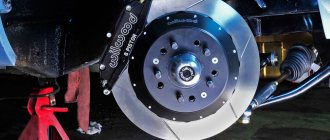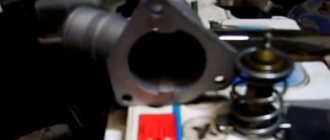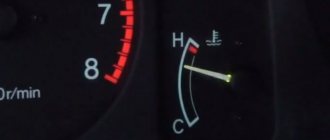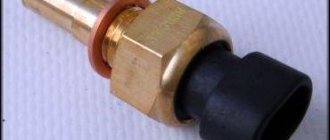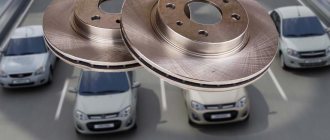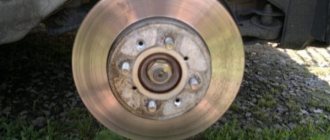Brake discs are designed to get hot. This is the only way to convert the kinetic energy of an accelerating car into thermal energy and then dissipate it in space. But this must happen strictly at the driver’s command. Heating of the brakes in all other cases indicates the presence of a malfunction, as well as emergency options, that is, excessive overheating.
Why do brake discs get hot?
The principle of its operation is based on an attempt to “put spokes in the wheels to stop the cart”, only in our case these are brake linings, which on both sides compress the brake disc rotating with the wheel and, due to friction, stop it. The energy released during friction and then absorbed by the discs is the reason for their heating - this is the result of a normal, working function.
When braking, they heat up quickly, but cool down more slowly, but with the expectation that the brakes will have time to cool down before the next press. Unfortunately, with frequent use of the brakes in the city cycle, and even in hot weather, this does not happen, which leads to their overheating.
The main reason for overheating is driving style. Aggressive driving, with sharp accelerations and hard braking, does not allow the brakes to cool down, and this ultimately leads to rapid wear of the brake system elements.
Moreover, the front brake discs heat up more, this is explained by their greater workload, due to the fact that the front of the car is always heavier than the rear. This effect is enhanced by the installation of drum brakes on the rear axle of the car, whose operating efficiency is lower, so the front discs are forced to take on their shortcomings. Malfunctions of the brake system, in which the linings constantly rub against the surface of the discs, are also the reasons for their overheating.
New pads made from low-quality materials also become a source of intense heat. To increase wear resistance, handicraft manufacturers add metal shavings to the friction mixture of the pads, which is what causes the temperature to rise.
Brake fluid
On older cars, the system was mechanically driven. Over time, manufacturers began to equip cars with more advanced systems. Nowadays hydraulics are used to drive the brakes. The use of such a drive made it possible to reduce the efforts that must be made to reduce speed. At the same time, the braking process itself has become more efficient due to the use of brake fluid.
It moves along the highways and puts pressure on the working cylinders, creating the necessary force to press the pads. Like all technical fluids, brake fluids have their own lifespan. Few people know about this, but it is true. And the operation of the cylinders in the caliper depends on the condition and characteristics of this fluid.
Automotive service experts recommend changing brake fluid once every two years. Why exactly this period? It's all about hygroscopicity. The fluid absorbs moisture, and the latter destroys parts of the brake system. Due to corrosion, the brake system piston cannot effectively press the pads. Situations often occur when the pistons jam in any one position.
The pad will constantly touch the disc. As a result, the latter will heat up. This is why brake discs get hot after replacing the pads. Old, erased elements did not reach the surface of the disk. And the new ones have a thicker friction lining. Hence the friction.
What is the repair method? The situation can be corrected by regularly replacing the brake fluid. This will avoid corrosion in the lines and system elements.
What is the normal temperature when the brake disc is operating?
The thermal conductivity of steel and alloy cast iron, from which brake discs are made, allows them to be maintained in working condition only when heated to temperatures in the range of +200 – 300˚С; further overheating can, at best, lead to the formation of a scalding film on the disc, worsening the coefficient friction, and in the worst case – to sticking of the linings or warping of the disc itself.
By the color of its surface you can determine how powerful the temperature effect was on it:
- at +150-280˚С it turns yellow and this is the norm;
- from a temperature of +300-450˚С – turns blue;
- +450-500˚С cause it to turn black, which should seriously alert the driver.
Operating temperature of disks in the city
Tell me, what is the typical temperature of the brake discs when driving around the city? To avoid traffic jams? And then on Saturday I installed EBC USR series wheels and EBC Greenstuff series 2000 pads. So far I have driven 80 km. For complete bedding in, they require driving 300 km. Those. they haven't gotten used to each other yet.
What I noticed is that after half an hour of driving in city mode, the temperature is already about 50-80 degrees. The truth doesn’t go any higher - after a couple of hours the same thing happens. Moreover, the front ones (ventilated) are at least 10 degrees colder than the rear ones (non-ventilated and smaller in diameter).
Before this, there were original wheels and pads from Mazda. With my riding style it was difficult to heat them up. Only if you accelerate quickly and then brake aggressively at traffic lights...
What do you think? I feel like this is the norm. But somehow unusual.
How the malfunction manifests itself
The malfunction, which results in intense heating of the brake disc, manifests itself as a characteristic metallic squeak from friction between metals. As a rule, one brake pad begins to jam, so the brake disc on one side overheats.
Curvature of the front discs, since they are the ones that most often suffer from such a defect, is accompanied, in addition to overheating, by a beating in the steering wheel when driving.
Severe wear of linings and discs (below the minimum permissible values) is manifested in a deterioration in their braking qualities and an increase in the distance required to stop the car. In addition, it may be accompanied by a squeak from the contact of the metal part of the pad with the disc shoulder and a decrease in the level of brake fluid in the master cylinder reservoir.
Tags: ebc greenstuff, ebc usr series
Comments 57
In the city up to 200 degrees, in the mountains with heavy braking up to 400.
I was playing around with a thermal imager. Brake discs from Mazda RX-8 are on the escape. With active pedaling, the outer diameter of up to 180 heats up inside 90, the brake caliper is about 80. Both the front and rear are approximately the same.
By the way, at small decelerations of 0.2-03 g (city mode), the rear brakes work very actively, because the redistribution of mass is insignificant. And since they are not ventilated and are much thinner, they heat up more. It's all simple.
Thank you! This is what confused me the most. Now I know.
How did you measure the temperature?
To the touch. But I'm buying a thermometer on Monday, so I'll measure it scientifically.
Write me a private message later. And so the average temperature is 170-250C. 250-400 with EMS test. At about 400C, fading occurs when you lose your brakes due to burnout of the binders. The most durable is Sunshine Premium. They did not crumble and the loss in braking force at P = const = 130 bar was less than 10%.
The advertisement promises durability up to 600 or 800 degrees. I’ll write a whole post as soon as I break in the brakes.
The problem is that the brake rotor may not be able to cope with such temperatures. The first signs of disk overheating are the steering wheel beating. This is due to deformation in the area of the so-called swan neck of the brake disc. If this happens, you must continue driving and try not to brake. If it stops immediately, the liquid may boil. From experience, I can say that it is possible to warm up the brakes to 600 degrees, but only in race track conditions and in the presence of a powerful engine. It won't work in the city. The brakes will have time to cool down. In laboratory conditions we heat up to 400 degrees, but this takes time. Up to 600 is possible, but the conditions there will be different. We imitate ordinary city cars, but here we have to imitate some kind of Porsche.
There is also the option of driving along serpentine roads in the mountains. I recently had an incident when I was driving downhill for about 10 kilometers. Or maybe more. The descent was about 20 degrees. Trucks and buses are prohibited from driving along that road out of harm's way. I was very afraid that I would overheat my stock brakes and fly down in full accordance with the laws of physics.
on serpentine roads - engine braking) although on automatic - xs)
I have a manual box. At this angle, engine braking is not enough - it still spins up the revs, even if you don’t press the gas pedal.
well, it usually rarely spins more than 3 thousand - it doesn’t seem to be scary)
There it was spinning around 4 thousand. Maybe I just did something wrong, of course.
then switch the gear down) as in the old books for drivers - from the middle of the last century)
No lower than the second 8). Mazda has the first one only for starting from a standstill.
the engine seems to be very easy to spin) on a Lada the engine slows down more) then go for 4 thousand) if you don’t want to be left without brakes)
hot, this is when the wheel rim cannot be touched.
50-80 degrees are cold.
I remember when the F1 mechanic was changing a tire in front of me, after the battle lap, you could see how hot he was. He simply threw the central nut aside, it was so hot.
The discs and pads are simply grinding in, there is a gap of a fraction of a millimeter, everything will settle down soon.
Are there garage workers in England or only official ones :)?
There are private garages, of course. Only the question of professionalism has not been canceled, has it?
I work at a relatively small station and now a lot of people are giving up service from dealers, spitting on warranties and so on. They come to get service from us.
Hot brakes are when you throw a handful of snow on them, and it evaporates before reaching them)) and everything else is cold))
I wish I could get a handful of snow! Everything is relative - I agree.
Yes, we have already run out of it too)) St. Petersburg on January 31 on the street +4))
How much did you get the wheels for and can you give me the part number if it’s not too much trouble?
Front wheels EBCUSR7310 (pair) - £150.36 or 16 thousand rubles at the exchange rate Rear wheels EBCUSR1197 (pair) - £123.95 or 13 thousand rubles at the rate
Plus the pads are still new. Plus installation work. I’ll write in the car’s log once I’ve completed the first 300 km on them - the minimum running-in required by the EBC.
this is normal) when I installed the new yolks and arrived home, I couldn’t touch the disk with my finger) but I drove about 30 km along the highway. After 300 km I honestly applied it and everything fell into place.
I'll keep track with a thermometer! It's interesting!
The Mazda ones, with a similar driving mode, heated up less, as far as I remember. So I was puzzled. I decided to buy a thermometer - then there will be accurate data. By the way, it will be possible to “try on” the wheels on my wife’s car - she has original ones - she presses the brakes less than me.
On average, new pads break in 500-1000 km.
Source
How to prevent overheating
In order to prevent the brakes from overheating, the main contribution is, of course, made by manufacturers, using the most heat-conducting materials for their manufacture and developing ventilated structures in which the brake discs consist of two parts, with a special fan built between them.
The design of the brake disc itself, capable of self-cleaning from dirt and being ventilated by oncoming flow, is considered one of the most successful design discoveries. In order to prevent overheating of the brakes during operation, it is necessary, first of all, to maintain the brake system in working condition, and for this you need to regularly check:
- brake fluid level in the master cylinder reservoir;
- brake disc thickness;
- brake pad wear.
Under no circumstances should you cool hot brake discs with cold water - a sharp temperature difference is the main reason for their warping. Before washing your car after a trip, you also need to give them time to cool down.
It is also important to change your driving style, get rid of jerky driving, use engine braking more often, shifting it to lower gears before stopping and on descents. This will not only prevent overheating of the brakes, but will also preserve the service life of its elements and many other parts of the car.
Long-term storage of a car outside the garage leads to the fact that, under the influence of precipitation, the metal parts of the brake pads become corroded and this causes them to jam.
Any motorist can deal with this problem, as well as replacing the pads, himself, since this is a simple procedure. To do this, you need to remove the wheel, unscrew the caliper, pull out the jammed pad, clean it of rust and put it in place (it should move easily along the guides).
If the thickness of the linings turns out to be about 2 mm, then it is better to replace them with new ones, without waiting for them to wear down to sizes below critical, and this must be done on both wheels of the axle, otherwise the car will skid to the side when braking. Manufacturers recommend replacing warped discs immediately, but our “Kulibins” have learned how to sharpen them and even have recommendations to do this after three pad replacements.
Regular inspection of the brake system, maintaining them “in constant combat readiness,” and careful driving are the key to safety, and often to the preservation of the life and health of the driver and those around him.
The situation is familiar: you replaced the brake pads and discs, but after 10-50 km they began to get very hot, did an uncharacteristic knocking sound appear? The first thought is “probably they haven’t gotten used to it yet.” However, when in addition an unpleasant, disturbing burning smell appears, the opinion changes. The mechanical components of the brake system must be installed carefully.
If the elements are poorly cleaned or an error is made during installation, friction will arise between them. The result is overheating.
The causes of problems may be different:
- Wedging of the brake caliper guides. Leads to uneven clamping of the pads.
- The inner pad and caliper piston are not aligned well enough. If the protrusions do not match, the parts will skew and a large load will arise.
- Incorrectly selected lubricant, poorly applied to the surface.
- The pads are stuck due to insufficient cleaning of the seat in the caliper bracket.
This is how overheating manifests itself
- Before installing the discs, they need to be degreased. Factory lubricant emits an unpleasant odor and smoke when the car is running. This will continue until the lubricant evaporates from the surface. You can determine whether there is lubrication yourself - just run your finger over the surface of the disc.
- Before installation, you need to clean the hub. Insufficient fit of parts can lead to their misalignment and, as a result, increased resistance during movement.
Cleaning the hub
- The caliper pins need to be cleaned of old grease. Then apply a new composition. Applying lubricant to the guides It is unacceptable to use grease, nigrol or another substance that is not a special means to lubricate the caliper fingers. The fingers will jam and the pads will get stuck in one position.
- Check the condition of the staples. The installation of caliper brackets is preceded by checking the fingers for care and return to their extreme positions.
- When the car is on a jack or lift, you should rotate the wheels to make sure that there is no strong friction.
If you have changed brake discs and pads and found that the disc is heating up, this is a signal - you will probably have to disassemble the brake system. When disassembling, follow this algorithm:
- Raise the car on a jack or hang it on a lift. It is important that the wheel where overheating occurs is free.
- Remove the wheel.
- Turn the steering wheel to its extreme position so that the brake system is accessible.
- Using the reverse spade side of the cylinder wrench, press out the caliper piston. To do this, you need to place the tool between the pad and the disc, then apply physical force.
- Bend out the retaining stop of the mounting bolt.
- Remove the staples.
Removing the bracket
- To release the bracket and fold it down, unscrew the bolt that secures it.
Next, act according to the situation - that is, depending on the cause of the malfunction. First of all, check the condition of the disks. They need to be degreased, even if there are no traces of oil.
Clean all components (especially the caliper) if there is dirt on them. Of course, do not forget to lubricate the guides with a special compound.
Disc brakes were invented back in the 20th century, but began to be actively used only in recent decades. It was then that the design of these systems was brought to perfection. Brakes are something that should always be in good working order. However, even this system sometimes fails. So, after some time, the driver begins to notice that the front brake discs are getting very hot. Is this normal? Of course not. And in today’s article we will look at why the front brake discs heat up and what is the reason for this phenomenon.
Overheating of brakes - root causes and signs of possible problems.
Hello everyone, I decided to touch on the topic of overheated brake discs. Below there will be one short but very interesting video about how even a relatively new disk (disks) with a mileage of less than 10 thousand km can be replaced.
So, what is “brake overheating”, why is it bad (dangerous) and how does it differ from the brake system operating “at the limit”? Let's start with the simplest and most basic - as standard, the car is equipped with a braking system sufficient for 4-fold sequential deceleration from cruising speed to minimum. This is the norm and is practically a dogma for the production of 90% of mass-produced cars. That is, if the car is accelerated to 90 km/h and braked to 10 km/h 4 times in a row without using the “emergency” braking mode, and the speed reduction parameters differ by no more than 8-10% (braking time and length of the route), then the braking system is considered effective. In addition, there are also parameters of economic feasibility and various other factors that influence which configuration of brake elements will be installed on a particular model. In most cases, the quality of operation of such a system is satisfactory for 90% of users.
However, there are those for whom this approach does not provide the necessary braking parameters; we will dwell on them in more detail.
Option 1
: With the same brake configuration, the machine is equipped with different types of motors that differ significantly in power. A typical example is our beloved Volvo 940. The engines were different - 2.4 liter diesel, 2.4 liter turbodiesel, 2 liter turbo16 valves, 2.3 liter turbo 8 valves, 2.3 liter atmospheric 8- and 16-valve engines - they were all equipped with the same system, within the production year, despite the fact that the engine power could differ, sometimes, by 2 times.
Option 2:
The car owner uses a very active (aggressive) driving style - constant acceleration-braking cycles and frequent row changes, which is almost always associated with the use of the braking system - if not for deceleration, then for the possibility of using it, if necessary. It is clear that this is not the “vegetable” mode that was used by the plant as a standard of behavior for the average user.
Option 3:
Emergency conditions - Emergency braking from maximum speed, long descent from a mountain pass, braking of a car with a heavily loaded trailer, long-term towing of a car (the towed car is constantly on the brakes), use of a car as an escort vehicle - the gas and brake pedals are pressed simultaneously almost all the time ( most often jeeps).
All these factors far exceed the basic calculations of any “stock” brakes in their loads and are the reasons for the ineffective operation of the standard braking system at the most crucial moment - when control over the control of the car and the safety of its passengers depend on it.
Signs that the brakes are working “at the limit” are blue stripes on the front brake discs, crunching and grinding noises when braking (if the brake pads are in normal condition), inadequate slowing down of the car as the force on the pedal increases - “pressed the pedal - at first it seemed to start braking, and then the slowdown is no longer felt, although you press harder,” is how clients describe it. All these symptoms occur due to the fact that the metal on the surface of the brake discs, in direct contact with the surface of the brake pads, is subjected to temperature loads that go beyond those acceptable for operation. As a result, the surface of the metal, heating and cooling, literally in a few cycles of such loads RECEIVES HARDENING, and hardened metal, if someone didn’t know, is a metal with a different structure. In practical terms, hardened metal is stronger than “raw” metal and does not allow the pads to scrape against themselves, changing part of their surface at reduced speed. THE PADS JUST SLIDE along the hardened surface of the disc - no matter how hard you press the brake pedal and no matter what kind of brakes you use, if the disc is overheated, then this is comparable to stuck calipers.
Now look at this old video - it was shot 2 years ago and has not lost any relevance or freshness:
Please note that the disc being replaced is practically new; it does not even have a lip on the outer edge where the pad does not rub. According to the owner, he drives extremely aggressively and because of this, he changes the wheels every 6-8 thousand. This, of course, is a combination of an overly powerful engine and an active driving style, but talking about changing discs more often than changing the oil in a car is not normal.
To summarize this post, I will publish my conclusion, which I determined for myself a long time ago: the capabilities of the braking system of your car should have a performance reserve that exceeds the output of your engine by 30-40% MINIMUM. That is, if your engine has 140 horsepower, then your brakes must be able to withstand the impact of a 180 horsepower engine. Otherwise - Houston, we have a PROBLEM.
Source
What is normal temperature?
Alloyed cast iron or steel is used as the material for the manufacture of these elements. There are also ceramic brake discs, however, due to their high cost, they are used only on expensive sports cars.
Although these elements are the least susceptible to overheating. Ceramics does not deform even at temperatures of a thousand degrees Celsius. As for conventional brake discs, which are equipped with 90% of cars, their operating temperature is up to 300 degrees Celsius.
Anything higher entails deformation and increased wear.
How does the braking system work?
The design of the car braking system is a bit like the shoe brake that most bicycles are equipped with. True, there is a slight difference: on a bicycle, when the brakes are applied, the pads come into friction with the rim, and on cars, with the brake disc (or drum). In addition, bicycle brakes are activated via a cable, while on cars they are activated hydraulically. The vehicle stops due to the creation of friction between the brake disc and pad. This process has its consequences, the main one of which is the formation of a large amount of heat that needs to be put somewhere. To remove the generated thermal energy, there is ventilation for the disc brakes, which was developed specifically for this purpose.
Disc brakes have repeatedly proven their effectiveness during numerous experiments, which automatically elevates them to first place among similar analogues. The temperature of the working surfaces is reduced due to air cooling: during operation, constant air circulation occurs in the system.
How does the braking system work?
The list of advantages of disc brakes also includes “autonomous” cleaning. The fast rotation speed of the discs removes all dirt and dust accumulated on the surface of the part. Many experts believe that the modern disc brake system is very popular due to its efficiency, the ability to make some adjustments to the system, reliability and long service life. The last point is very relevant, given the current prices for spare parts.
Requirements
There are several requirements for brake discs. They must be durable, resistant to thermal shock and have high thermal conductivity. Brake discs also have good adhesion and a high coefficient of friction. Only if all these parameters are met, wheels can be installed on a production car. Otherwise, traffic safety will be in question. If the pads overheat, they will simply slide across the working surface, not performing their main functions - friction and adhesion.
Motorists are wondering: why does the front brake disc get hot? The reason for this phenomenon is related to its main function - inhibition. So, when you press the pedal, the pads begin to interact with the surface of the disc. At this moment, the heating of the element is at its peak value. The longer the pad is in engagement with the disc, the higher the temperature of the metal.
Heating occurs instantly. However, the cooling time is tens of times longer. Of course, a lot depends on your driving style.
If you drive the car aggressively, even a normal disc will not have time to cool down (unless it is made of ceramic). What to do in such a situation? If your front right brake disc is overheating, then you need to reconsider your driving style.
Count how many times you press the pedal over a certain section of the journey. But it happens that the metal heats up even when driving calmly.
So, the next reason that needs to be considered is a malfunction of the brake system itself. Check the fluid level in the reservoir. If it is not enough, add the required amount.
Also remember that brake fluid has a service life of no more than two years. Why is this so? The fact is that such a liquid is very hygroscopic - it easily absorbs moisture.
Now let's move directly to the mechanical part. The first thing you should pay attention to is the pads. There is friction material on their surface.
This pad has special wear marks. When the layer is less than three millimeters, the part needs to be replaced. Otherwise, the heating coefficient will increase - metal will rub against metal.
Should the front brake discs get hot? Of course not. If the pads are worn down to the ground, at one point they may simply jam.
The car will skid. Don’t delay installing new ones - change the pads according to the regulations. It ranges from 20 to 30 thousand kilometers.
Possible consequences
The main consequences of overheating are poor performance of the braking system. The pad will slide over the hot disc without proper grip, the car will not stop at the right time and an accident or other unforeseen situation may occur. After several acceleration-braking cycles, when the brakes are heated to 400-450 degrees, they may disappear completely until they cool completely. Overheating of the discs will lead to boiling of the brake fluid and, as a result, complete failure of the system.
Discs
Check its thickness. Often the front brake discs on UAZ Patriot cars get hot due to the banal wear of the working surface. Some people use a groove.
However, this can only be done once. Better yet, immediately change the disk to a new one.
Its resource is an order of magnitude greater than that of the pads - 150-200 thousand kilometers. However, many people forget about it and drive with worn out discs, not suspecting that the brakes will soon get hot.
Stopping support
If the brake discs get very hot after replacing the pads, then you should carefully examine this element. The caliper may simply jam. In this case, the pad will not evenly adhere to the surface of the disc. Due to this, the friction coefficient increases. You should also make sure that the caliper guides are well lubricated. If there is no lubricant, it is necessary to treat each guide and the entire caliper mechanism with it. When driving a car with worn brake pads, the system piston may come out of the cylinder higher than normal. The mirror in the place where the piston should be will oxidize or become damaged. Once new pads are installed, the element will not return to its normal position. This problem can be solved by replacing the caliper repair kit. It is also recommended to check the condition of the anthers. If cracks appear in them, they should be replaced. Dust and dirt are one of the reasons for a stuck caliper.
Determining the state of the disk
To find out the exact reason, you need to make sure that the disk was actually operating under high loads. How to do it? You can determine the condition of the working surface visually by color.
You won't need a pyrometer. So, if the surface of the disk is blue, it means the metal was heated to 450 degrees Celsius. It's worse if the shade is black.
In this case, there is every reason to assume that the brakes heated up to 500 degrees Celsius.
Useful tips
The fact that the brake elements are overheating is far from the most pleasant news for the car owner.
After all, to fix the problem, a complete replacement or re-grooving of the part is required (which is also not a cheap pleasure). How to prevent this? You can save disks; to do this, you need to follow a few simple rules:
- Avoid any contact of water with the calipers. Do not drive aggressively in wet or rainy weather.
- Particular attention should be paid to washing. Wait a while for your discs to cool down. If water gets on hot metal, deformation cannot be avoided. In this case, only complete replacement of the disks will save you. Moreover, they are changed in pairs (just like the pads), even if the adjacent one is in good condition.
- Follow the instructions for replacing pads. Don't wait until they wear down to metal. This will cause deformation and increased heating of the disk.
